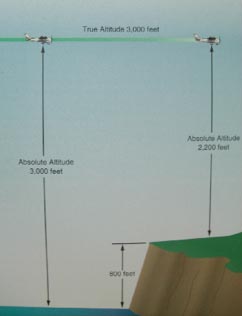Glossary of Aviation Terms | Absolute Altitude
Absolute Altitude | Paramount Business Jets
Simply put, absolute altitude is the height of the aircraft above the actual landscape or terrain over which it is flying. When an altimeter measures altitude, it measures the vertical elevation above a reference point. This point could be the mean sea level, the surface of the earth, or some other point. For this reason, there are different types of altitude, which include: indicated, pressure, density, true, calibrated, and absolute. This last type of altitude varies with not only the height of the plane but also the height of the surface because it uses the ground or surface underneath the aircraft as its reference point. It is commonly referred to as high above ground level, or AGL.
It is important that the various "altitudes" in aviation are distinguished by modifiers, such as true, absolute, indicated, pressure, and density altitude. The purpose of differentiating the types of altitudes is to ensure the safety of the parties communicating to each other about their vertical location in the sky. All parties exchanging information must understand which definition of altitude is being used to avoid confusion and mid-air collisions.

Explore More Aviation Terminology
- Amphibious floats | Paramount Business Jets
- GPWS | Paramount Business Jets
- Altimeter | Paramount Business Jets
- Roger | Paramount Business Jets
- Approach (Departure) Control | Paramount Business Jets
- Contrail Streaks | Paramount Business Jets
- Sigmet | Paramount Business Jets
- Point to Point Pricing | Paramount Business Jets
- EGPWS | Paramount Business Jets
